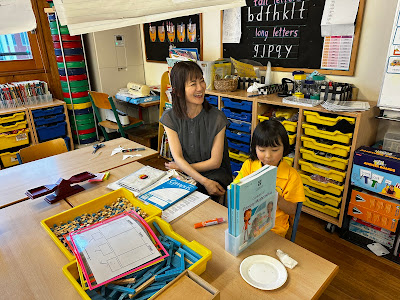Preschoolers practice for their upcoming Student Led Conference (SLC) by engaging in mock sessions with peers and teachers. These practices help the students build confidence as they learn to talk about their artwork, classroom routines, and personal growth.
Using the checklist prompted by visuals like portfolios and photo displays, preschoolers explain their learning journey in simple, meaningful ways. Practicing ahead of the actual conference allows them to feel prepared and proud to share with their families.
It fosters communication skills, independence, and a strong sense of ownership over their learning — all foundational for future academic and social success.
During the actual Student Led Conference, preschoolers experienced a range of emotions. Some felt nervous facing their parents, while others were visibly tired or overwhelmed by the attention.
A few needed gentle support to stay engaged. On the other hand, many confidently shared their work, explained classroom routines, and beamed with pride.
Each child’s experience—whether smooth or challenging—is a valuable milestone in their learning journey. These moments build resilience, self-awareness, and communication skills.
It's important to honor all reactions, as they reflect growth. Celebrating every child’s effort helps them feel valued and encourages continued confidence in their learning path.
As they grow and mature over the summer, I am confident that this experience—where they actively took the lead—will become a strong foundation for future responsibilities and continued success in learning.
Taking ownership of their progress, sharing their stories, and engaging with their parents in a meaningful way is no small feat for a preschooler. This Student Led Conference marks more than just a school event; it is a rite of passage.
They will carry this memory with pride—as the night they began their journey toward becoming fully-fledged primary students at DSKI, ready to embrace the next chapter with confidence.










Comments
Post a Comment